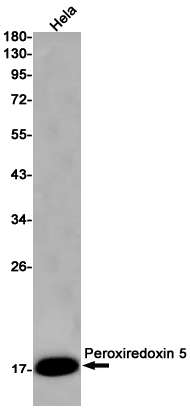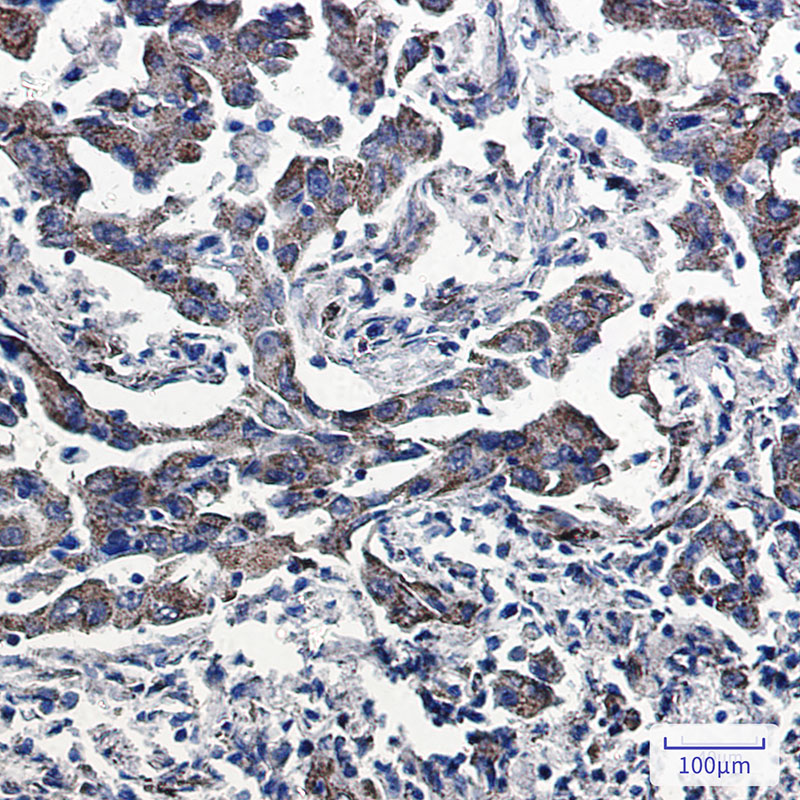

| WB | 1/500-1/1000 | Human,Mouse,Rat |
| IF | 1/20 | Human,Mouse,Rat |
| IHC | 1/50-1/100 | Human,Mouse,Rat |
| ICC | 技术咨询 | Human,Mouse,Rat |
| FCM | 咨询技术 | Human,Mouse,Rat |
| Elisa | 咨询技术 | Human,Mouse,Rat |
| Aliases | ACR1; AOEB166; B166; Peroxiredoxin V; Peroxiredoxin-5; PLP; PMP20; PRDX5; PRDX6; Prx-V; PRXV; SBBI10; Thioredoxin reductase |
| Entrez GeneID | 25824 |
| WB Predicted band size | Calculated MW: 22 kDa; Observed MW: 17 kDa |
| Host/Isotype | Rabbit IgG |
| Antibody Type | Primary antibody |
| Storage | Store at 4°C short term. Aliquot and store at -20°C long term. Avoid freeze/thaw cycles. |
| Species Reactivity | Human,Mouse,Rat |
| Immunogen | A synthetic peptide of human Peroxiredoxin 5 |
| Formulation | Purified antibody in TBS with 0.05% sodium azide,0.05%BSA and 50% glycerol. |
+ +
以下是关于Peroxiredoxin 5(Prdx5)抗体的3篇参考文献及其摘要概述:
1. **文献名称**:*"Peroxiredoxin 5: Structure, regulation, and functions in antioxidant defense and redox signaling"*
**作者**:Knoops B, Argyropoulou V, Becker S, et al.
**摘要内容**:该综述总结了Prdx5的结构和生物学功能,重点讨论了其在氧化应激反应中的抗氧化机制。文中提到利用特异性抗体揭示Prdx5在亚细胞定位中的分布差异,并强调其在炎症和癌症中的潜在作用。
2. **文献名称**:*"Increased expression of peroxiredoxin 5 in Alzheimer's disease amyloid plaques: Possible role in oxidative stress resistance"*
**作者**:Seo JH, Kim C, Ahn Y, et al.
**摘要内容**:研究通过免疫组化结合Prdx5抗体发现,阿尔茨海默病患者脑部淀粉样斑块中Prdx5表达显著升高,提示其可能通过清除活性氧(ROS)保护神经元免受氧化损伤。
3. **文献名称**:*"Peroxiredoxin 5 is a key antioxidant enzyme in prostate cancer progression and metastasis"*
**作者**:Wang H, Zhang D, Zhang M, et al.
**摘要内容**:该研究利用Prdx5抗体进行Western blot和免疫荧光分析,发现Prdx5在前列腺癌转移组织中高表达,其通过调控NF-κB通路促进肿瘤侵袭,提示其作为癌症治疗靶点的潜力。
**备注**:以上文献为示例,实际引用时需核对作者、期刊及发表年份的准确性。建议通过PubMed或Web of Science以关键词“Prdx5 antibody”或“Peroxiredoxin 5 antibody”检索最新文献。
Peroxiredoxin 5 (Prdx5) is a member of the peroxiredoxin family, a group of antioxidant enzymes critical for regulating cellular redox homeostasis by scavenging reactive oxygen species (ROS), particularly hydrogen peroxide (H₂O₂). Prdx5 is unique due to its broad substrate specificity and ability to localize to multiple subcellular compartments, including the cytoplasm, mitochondria, nucleus, and peroxisomes. It plays a vital role in protecting cells from oxidative damage, modulating signaling pathways, and influencing processes like apoptosis, inflammation, and cell proliferation.
Antibodies targeting Prdx5 are essential tools for studying its expression, localization, and function in various biological contexts. These antibodies are widely used in techniques such as Western blotting, immunohistochemistry (IHC), immunofluorescence (IF), and ELISA to detect Prdx5 levels in tissues or cultured cells. Researchers employ Prdx5 antibodies to investigate its involvement in diseases linked to oxidative stress, including cancer, neurodegenerative disorders, cardiovascular diseases, and aging-related conditions.
Prdx5 antibodies are typically generated using specific epitopes of the protein, such as its conserved catalytic region or unique structural domains, ensuring specificity. Both polyclonal and monoclonal variants are available, with validation often performed using knockout (KO) models or siRNA knockdown to confirm target specificity. As redox dysregulation gains attention in pathophysiology, Prdx5 antibodies remain pivotal for unraveling the protein's role in health and disease, offering insights into potential therapeutic strategies targeting oxidative stress pathways.
×